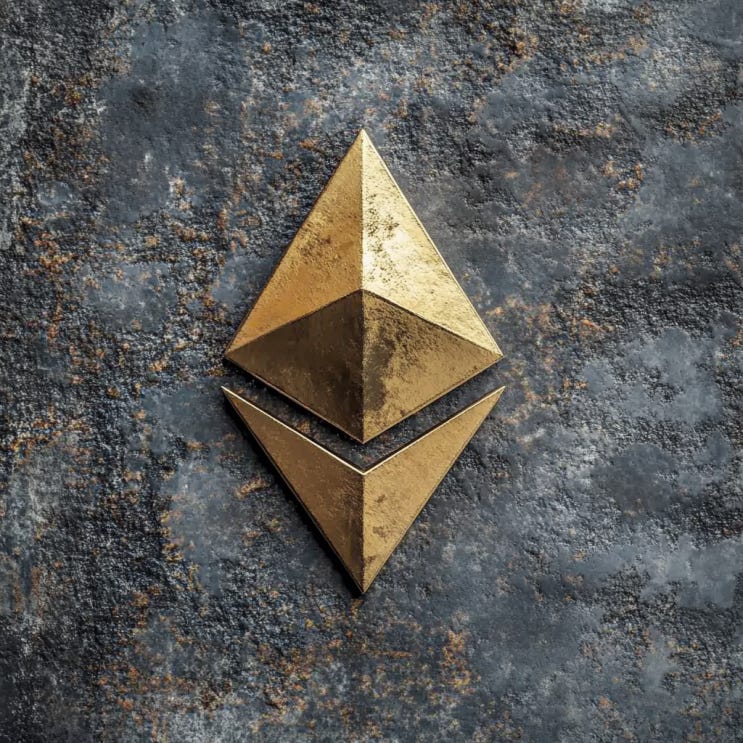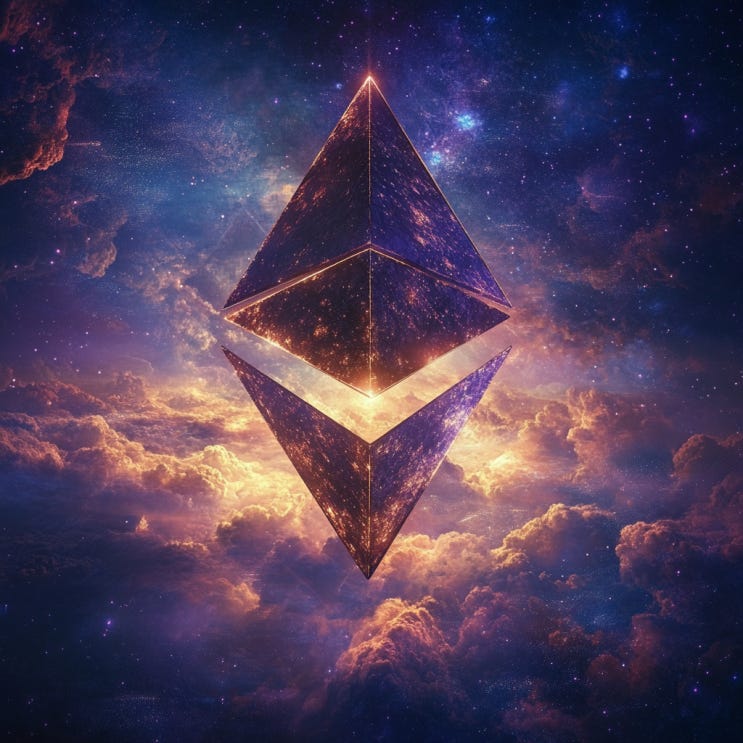“Beam Chain” (which some referred to as “Ethereum 3.0”) is a potential large-scale upgrade to the consensus layer of the Ethereum network, proposed by Ethereum Foundation researcher Justin Drake at Devcon SEA.
As Ethereum continues its evolution to address scalability, speed, and accessibility, Beam Chain could build upon previous milestones like the "Merge" (Ethereum 2.0) and upcoming "Dencun" upgrades.
The proposal’s fundamental objectives are to enhance transaction throughput and reduce latency, improve accessibility to validator participation, and introduce native cryptographic technologies for a more robust network.
Currently, the Beam Chain proposal is in the early discussion phase.
Ethereum “Beam Chain” Proposal: Major Details
1. Technical Improvements
Slot Time Reduction from 12 to 4 Seconds: By reducing the time for each slot from 12 seconds to just 4 seconds, Beam Chain aims to significantly accelerate the processing and validation of blocks on the network. Shorter slot times not only increase Ethereum’s overall transaction capacity but also improve user experience by minimizing latency. This reduced block time is crucial for achieving near-instant finality, making Ethereum more suitable for high-frequency applications and users accustomed to fast transaction speeds.
Removal of the Epoch System: In the current Ethereum structure, an epoch groups a set of slots to manage validator duties and other protocol operations. Beam Chain’s proposal to eliminate this system is a fundamental restructuring aimed at streamlining block validation and reducing latency. Without epochs, Ethereum would operate with a more straightforward block generation sequence, reducing administrative complexities and allowing for a leaner, faster-running network.
2. Staking Adjustments
Lower Minimum Stake Requirement (1 ETH): One of Beam Chain’s most transformative proposals is lowering the minimum stake from 32 ETH to just 1 ETH. This change aims to expand access to the Ethereum validator set, promoting decentralization and enabling a more diverse set of participants. Currently, the high minimum stake requirement acts as a barrier to many would-be validators, centralizing network control to wealthier participants. By reducing this requirement, Beam Chain encourages broader participation and creates a more resilient network with lower risks of concentration and collusion.
Staking Cap System: In addition to lowering the entry threshold, the Beam Chain proposal introduces a staking cap per validator. This cap would limit the maximum amount of ETH any single validator can stake, further decentralizing the validation process and discouraging any validator or entity from monopolizing control over the network. By capping staking contributions, Ethereum 3.0 aims to prevent scenarios where a single validator or a few large validators dominate, increasing both the network’s security and resilience to malicious attacks.
3. Integration of Zero-Knowledge Ethereum Virtual Machine (zkEVM)
zkEVM Native Integration: Beam Chain proposes the integration of zkEVM directly into the Ethereum mainnet, allowing the blockchain to perform scalable transaction verification using zero-knowledge proofs. Zero-knowledge technology is revolutionary for blockchain scalability, as it enables nodes to verify the validity of transactions without processing the entire transaction history. zkEVM integration means that computationally intense operations can be verified quickly and in a more privacy-conscious manner.
Layer 2 Reduction with zkEVM: By integrating zkEVM at the mainnet level, Beam Chain minimizes the need for Layer 2 rollups to handle scalability. Layer 2 solutions, while effective, add complexity and cost. Direct zkEVM on the mainnet would streamline transaction processing, reduce gas fees, and increase Ethereum’s transaction throughput, creating a more seamless and cost-effective experience for developers and users alike.
4. Enhanced Cryptographic Features
Use of SNARKs (Succinct Non-Interactive Argument of Knowledge): SNARKs allow validators to verify complex computations succinctly and without interaction between prover and verifier, enhancing both scalability and privacy. With SNARKs, validators can confirm transaction legitimacy without revealing transaction details, a key advantage for privacy-sensitive applications. This feature not only scales the blockchain but also supports Ethereum’s transition toward more secure and confidential transaction methods.
Post-Quantum Security: A forward-looking aspect of Beam Chain is its emphasis on post-quantum security. Quantum computing, once fully realized, has the potential to disrupt traditional cryptographic algorithms, posing a threat to blockchain security. Beam Chain’s integration of quantum-resistant cryptographic protocols prepares Ethereum for the advent of quantum computing, helping ensure Ethereum remains secure against quantum-level threats in the future.
Security & Efficiency Goals of Beam Chain
1. Advanced Cryptographic Security
The integration of post-quantum cryptography and zkEVM is a leap forward in blockchain security.
Quantum-resistant algorithms provide Ethereum a defensive advantage against future threats from quantum computing, which could otherwise undermine traditional cryptographic methods.
Meanwhile, zero-knowledge proof systems such as SNARKs strengthen data privacy, enabling the network to handle confidential transactions efficiently without exposing sensitive information.
2. Network Efficiency
By addressing transaction verification directly on the mainnet through zkEVM, Beam Chain maximizes efficiency, minimizes congestion, and reduces costs associated with Layer 2 reliance.
SNARKs further optimize network speed by reducing computational demands on nodes, creating a leaner, more resilient ecosystem capable of supporting high transaction volumes without sacrificing speed or security.
Dev Criticisms of Justin Drake's “Beam Chain” Proposal
Ethereum Foundation researcher Justin Drake's recent "Beam Chain" proposal has elicited a range of reactions from the Ethereum developer community.
Critical Responses
Martin Köppelmann, co-founder of Gnosis, characterized the proposal as "a big refactoring" and suggested that "Ethereum needs to be more ambitious than this."
José Maria Macedo of Delphi Digital expressed disappointment, arguing that the proposal isn't sufficient to make Ethereum's Layer 1 competitive.
Péter Szilágyi, an Ethereum core developer, raised concerns about implementing multiple changes simultaneously, suggesting that some could be addressed independently and more promptly.
Bowen Li, principal engineer at EigenLayer, criticized the proposed five-year timeline, comparing it unfavorably to the rapid advancements of companies like SpaceX.
@0xngmi, a developer from DefiLlama, advocated for an "Ethereum Acceleration" approach, implying a need for a more expedited development process.
Luis Cuende, co-founder of Aragon, criticized the focus on technical improvements stating “Users don’t care about either, change the culture.”
Notable Absences
As of now, Ethereum co-founder Vitalik Buterin has not publicly commented on the Beam Chain proposal.
Overall, the proposal has sparked more criticism than support among prominent Ethereum developers, with primary concerns focusing on the lengthy implementation timeline and debates over the proposal's ambition and feasibility.
Proposed Implementation Timeline for Beam Chain (ETH 3.0)
Ethereum 3.0 is still in its proposal and community feedback stage, with extensive testing and phased releases anticipated to start around 2027.
Ethereum’s development team and community members will likely conduct multiple rounds of testing to validate each feature and address technical challenges before implementation.
This phased approach ensures that each component—such as zkEVM and SNARKs—is rigorously evaluated under simulated network conditions and real-world scenarios.
The timeline will depend heavily on the outcomes of initial testing and community support, as Ethereum upgrades require consensus from node operators, developers, and users.
If fully approved, Beam Chain will usher in a new phase of Ethereum’s evolution, designed to be highly scalable, accessible, and secure.
Beam Chain Proposal: Motivations & Potential Trade-offs
Ethereum researcher Justin Drake's "Beam Chain" proposal aims to position Ethereum as a more scalable, secure, and inclusive blockchain, with improvements that could help it stay competitive amid advancements from other blockchains like Solana.
Motivations Behind the Beam Chain Proposal
Scalability Enhancements: The proposal tackles network congestion by reducing slot times from 12 seconds to 4 seconds, accelerating transaction processing speeds to match or exceed the capabilities of other blockchains, such as Solana, that emphasize high throughput.
Competitive Edge: As blockchain technology evolves, Ethereum faces competition from networks designed for speed and scalability. By implementing Beam Chain, Ethereum seeks to retain its position as a leading platform, particularly as its applications span DeFi, NFTs, and beyond.
Democratization of Staking: Lowering the staking requirement from 32 ETH to just 1 ETH aims to increase validator participation, making the network more inclusive and decentralized by allowing a broader range of users to participate.
Advanced Cryptographic Security: The proposal includes Zero-Knowledge Succinct Non-Interactive Argument of Knowledge (zk-SNARKs) and post-quantum cryptography, enhancing the network's resilience against future cryptographic threats and bolstering its security.
Potential Trade-offs and Considerations
Centralization Risks: Larger blocks and professional block builders could increase centralization pressure, potentially undermining Ethereum’s decentralized ethos as more sophisticated participants might dominate validation.
Impact on Layer 2 Ecosystem: By increasing Layer 1 scalability, Beam Chain could lessen the demand for Layer 2 solutions, potentially disrupting projects and businesses that have invested in Layer 2 infrastructure.
Implementation Challenges: The scope of the proposed changes requires rigorous testing, posing security risks during the transition and necessitating updates to the broader Ethereum infrastructure.
Economic Implications: Reducing staking requirements and adjusting validator rewards could alter the existing DeFi landscape, impacting projects reliant on Ethereum’s current economic model.
Comparative Analysis: Current Network (ETH 2.0) vs. Beam Chain (ETH 3.0)
Current Network:
Pros: Established, stable infrastructure; Layer 2 solutions have been effective at scaling; proven security.
Cons: Scalability limitations, high staking requirements, potential for future cryptographic vulnerabilities.
Beam Chain Transition:
Pros: Faster transaction speeds; expanded validator participation due to lower thresholds; advanced security through zk-SNARKs.
Cons: Increased centralization risks; disruption to the Layer 2 ecosystem; complex implementation requiring significant testing and community buy-in.
The Beam Chain proposal aims to align Ethereum with evolving blockchain standards, balancing competitive performance enhancements with the challenges of a complex and potentially disruptive network upgrade.
Will the Ethereum 3.0 (Beam Chain) Proposal Pass?
The Beam Chain proposal is actively being developed, and due to the involvement of influential developers like Justin Drake, we are likely to know whether it will be approved by 2025 or 2026.
Testing could start shortly after, with a possible implementation target of 2028-2030 if all stages progress as planned.
1. Current Status of the Beam Chain Proposal
Draft Phase: The Beam Chain proposal is currently in its initial stages.
Justin Drake, a prominent figure in the Ethereum community, is leading the efforts, which indicates that it is likely being taken seriously by the core developers.
2. Timeline for Knowing Whether Beam Chain Will Be Approved
Shorter Decision Timeline: Given Justin Drake's involvement and the significance of this proposal, it's likely that we will know by 2025 or 2026 whether the Beam Chain proposal has enough support to move forward.
Typically, major Ethereum upgrades do not sit in limbo for too long if they have significant developer backing. The All Core Developers (ACD) calls are a key forum where these proposals are reviewed, discussed, and decided upon.
If the proposal gains initial traction and passes the necessary review stages, it could move forward into formal testing as early as 2026.
3. What Is the Approval Process?
Ethereum Improvement Proposal (EIP) Stages:
Draft and Review: Currently, Beam Chain is in the drafting phase. During the Review Phase, official editors and core developers assess the proposal for feasibility and alignment with Ethereum’s goals.
Last Call (Public Review): The proposal must go through a public review period where community members provide feedback. This process is meant to gather diverse perspectives and ensure no major issues are overlooked.
Final Approval: After the public review, the core developers will decide whether to proceed with implementation.
4. How Likely Is Implementation?
High Interest & Community Support: With significant contributors like Justin Drake pushing for Beam Chain, it is likely to receive considerable attention and scrutiny.
If consensus among developers and community support are reached during the 2025-2026 review phases, we could see Beam Chain proceed to the testing stage.
5. Realistic Timeline for Implementation
Testing Phase: Testing could begin by late 2026 or early 2027 if everything proceeds smoothly.
Implementation Target: If Beam Chain proves successful during the testing stage, we could see it implemented as part of Ethereum 3.0 by 2028-2030.
Potential Impact of Beam Chain (ETH 3.0) on Layer 2 Scaling Solutions
Ethereum 3.0 will transform the main network's efficiency and scalability, potentially decreasing the dependency on Layer 2 scaling solutions.
However, Layer 2 will still maintain its importance by focusing on specialized use cases, offering additional functionalities beyond what Layer 1 improvements can provide.
The enhancements in validator participation and network performance will contribute to a more accessible and robust Ethereum ecosystem.
1. Impact on Layer 2 Solutions
Reduced Reliance on Layer 2 Scaling: Ethereum 3.0, with its integration of zkEVM and SNARKs, aims to significantly improve mainnet scalability. This could reduce the necessity of some Layer 2 scaling solutions that have been crucial for handling network congestion and high gas fees. Improved Layer 1 efficiency will mean that fewer users will need to rely on Layer 2 to achieve affordable and fast transactions.
Specialized Role for Layer 2: Despite these improvements, Layer 2 solutions are likely to remain essential. Many Layer 2 networks provide specialized features beyond scaling, such as privacy layers, advanced DeFi capabilities, and cross-chain solutions. Even with a more scalable Ethereum mainnet, Layer 2 solutions will likely continue to play a crucial role in serving niche use cases that require more flexibility or specific optimizations.
Economic Impact on Layer 2 Projects: As mainnet scalability improves, the usage pattern of Layer 2 solutions may shift, focusing more on specialized value propositions rather than solely providing scalability. The value of Layer 2 tokens and their Total Value Locked (TVL) may still grow as they adapt to new roles within the ecosystem, especially in areas like governance and application-specific enhancements.
2. Impact on Network Functionality
Enhanced Network Performance: Ethereum 3.0 will introduce several key upgrades, including reducing slot times from 12 seconds to 4 seconds and achieving block finalization within three slots. These changes will make transactions faster and finalization times significantly shorter, leading to a much smoother user experience and higher throughput.
Validator Accessibility: The proposal also aims to make validating more accessible by reducing the minimum stake requirement from 32 ETH to just 1 ETH. This change, along with staking caps to prevent centralization, will make participation in network security more inclusive, ultimately enhancing decentralization and network resilience.
Scalability and Efficiency: With Ethereum 3.0's upgrades, the base layer will become more scalable and efficient, allowing the network to handle increased demand without compromising on performance. This will directly benefit users by reducing gas fees during high traffic periods and improving transaction speeds across the board.
What effect would Ethereum (ETH) 3.0 (Beam Chain) likely have on the value of the Ethereum network?
Beam Chain would significantly enhance network scalability, utility, and accessibility, leading to increased demand for ETH, reduced circulating supply through staking, and improved market sentiment.
These factors collectively would likely to drive up the value of the Ethereum network.
1. Increased Utility Drives Demand
Scalability and Lower Gas Fees: By improving scalability and reducing transaction costs, Ethereum 3.0 will make the network more attractive for users and developers, leading to increased usage of dApps, DeFi platforms, and other services.
This increased utility is likely to drive demand for ETH, which is required for transactions, thereby increasing its value.
2. Reduced Supply Through Staking
Expanded Validator Participation: Lowering the staking requirement from 32 ETH to 1 ETH will enable more users to participate in staking.
Increased staking will lock up more ETH, reducing circulating supply and putting upward pressure on its value.
More validators also mean enhanced security, further boosting investor confidence.
3. Enhanced Market Perception
Network Improvements Bolster Confidence: The successful rollout of Ethereum 3.0 will strengthen Ethereum's competitive position against other Layer 1 blockchains.
Enhanced scalability, security, and decentralization will likely boost investor sentiment, leading to increased buying pressure and higher valuation.
4. Layer 2 Solutions and Economic Effects
Shift in Layer 2 Usage: Improved mainnet scalability may reduce the reliance on Layer 2 solutions, driving some activity back to Layer 1.
This increased Layer 1 usage will boost ETH demand for transactions, positively impacting its value.
However, Layer 2 protocols focusing on niche features will still contribute to network activity, indirectly supporting the value of ETH.
How Fast Could Beam Chain Be Implemented on Ethereum?
The timeline for Beam Chain, or Ethereum 3.0, is projected to span several years, beginning with research in 2025, development in 2026, and comprehensive testing through 2027-2028.
While this timeline reflects a cautious approach, the question is whether Beam Chain could be implemented more quickly.
Challenges in Accelerating Implementation
Security Considerations
Beam Chain aims to secure over $60 billion in Total Value Locked (TVL) and manage $400 billion in assets.
Security is the highest priority, and a rushed approach could introduce vulnerabilities that lead to catastrophic losses.
This necessitates careful planning, coding, and extensive testing to ensure robustness.
Technical Complexity
Implementing Beam Chain involves significant technical advancements, including:
Integration of new cryptographic systems.
Adoption of SNARKs technology.
Implementation of post-quantum security measures.
Validator infrastructure changes.
Each of these advancements requires careful development to maintain backward compatibility and social consensus, both of which are difficult and time-consuming tasks that cannot be easily accelerated without risk.
Testing Requirements
Testing for Beam Chain involves validating numerous technological improvements under various stress scenarios.
Given the foundational nature of these changes, testing has to be comprehensive to avoid unforeseen issues that could endanger the network.
Potential Acceleration with AI?
Recent advances in artificial intelligence (AI) provide some opportunities for accelerating the implementation:
Automated Code Generation and Testing: AI tools could speed up the development of production-grade code, automating repetitive or tedious tasks and potentially reducing the time required for development and debugging.
Enhanced Security Audits: AI could aid in identifying vulnerabilities more efficiently, thus accelerating the audit phase. Automating parts of the security review could potentially save months of work compared to traditional manual audits.
Validator Simulations: AI could help model validator behavior and optimize consensus mechanisms through simulations, streamlining parts of the testing phase.
Limits to AI Acceleration
Despite the potential of AI, several factors limit how quickly Beam Chain can be implemented:
Human Oversight & Trust: AI-generated code or analysis still requires human validation to ensure its quality and suitability for such a critical infrastructure project. This means that while AI can assist, the need for human oversight remains a bottleneck.
Consensus Building: Beam Chain requires social consensus from the Ethereum community. Changes of this magnitude need widespread support, and the process of reaching that consensus, including debates and proposal refinements, takes time. AI cannot accelerate community acceptance.
Complex Integration: The integration of new technologies—such as SNARKs and post-quantum cryptography—requires extensive manual work to balance new features with the legacy system. This complexity makes it challenging to fully automate or accelerate with AI alone.
Though AI tools could improve the efficiency of certain phases, such as code development, security audits, and validator testing, the core challenges of Beam Chain—security, social consensus, and technical complexity—require a cautious and deliberate approach.
As a result, Beam Chain’s implementation may benefit from AI enhancements, but it is unlikely to achieve a significantly accelerated timeline without introducing additional risks.
The conservative, step-by-step approach remains the safest path to ensure the stability of such a valuable and complex ecosystem.
Is Ethereum Falling Behind Solana? Analyzing the Beam Chain Proposal's Potential Impact
As Ethereum and Solana compete for dominance in the blockchain space, each platform exhibits distinct strengths, but Solana currently leads in raw performance metrics such as transaction speed and cost-effectiveness.
Justin Drake’s Beam Chain proposal aims to bring Ethereum closer to Solana's performance level, but substantial challenges and trade-offs remain.
Ethereum vs. Solana: Chain Comparison
Transaction Speed (TPS)
Solana: Solana processes over 50,000 transactions per second (TPS) in optimal conditions, a metric that places it far ahead of most blockchains in speed. This performance has made Solana highly attractive for high-frequency applications, particularly in areas like gaming and DeFi.
Ethereum: Currently, Ethereum supports approximately 15-30 TPS, depending on network activity. Although Layer 2 solutions (like Optimism and Arbitrum) increase throughput by offloading some transactions, Ethereum’s base layer remains slower than Solana’s.
Cost Structure (Transaction Fees)
Solana: Average transaction fees on Solana are a fraction of a cent (around $0.00025), which has helped it grow quickly among cost-sensitive users and applications.
Ethereum: Ethereum’s transaction fees fluctuate significantly, ranging from $1 to $30 or more during high-demand periods. This variability has led to the development of Layer 2 scaling solutions, but the mainnet fees remain a barrier for mass adoption in cost-sensitive applications.
User Activity
Solana: Solana has reported over 3 million daily active users, a sign of its scalability and efficiency in handling large user volumes.
Ethereum: With approximately 410,000 daily active users, Ethereum still attracts a loyal user base, particularly for high-value and DeFi applications. However, the lower activity compared to Solana reflects limitations in transaction speed and cost.
Ethereum’s Enduring Strengths
While Solana leads in raw performance, Ethereum boasts several fundamental advantages that support its long-term position.
Established Ecosystem (Network Effect): Ethereum’s mature ecosystem includes a vast array of decentralized applications (dApps), a robust developer community, and a comprehensive DeFi infrastructure. These factors have entrenched Ethereum as a foundational layer for decentralized applications and finance.
Institutional Adoption: Ethereum’s widespread use in institutional finance—seen through ETF approvals and adoption by traditional financial entities—gives it a degree of stability and credibility. This institutional interest supports Ethereum’s long-term viability, particularly in regulated financial environments.
Security & Decentralization: Ethereum’s extensive network of validators and nodes offers superior security and decentralization, which are crucial for high-stakes applications in finance and other sectors where trust is paramount.
The Beam Chain Proposal: What It Could Mean for Ethereum
The Beam Chain proposal aims to address Ethereum’s core limitations in speed and scalability with several key changes.
Reduced Slot Times: Reducing slot times from 12 seconds to 4 seconds would allow Ethereum to process transactions more rapidly, helping to close the performance gap with Solana.
Lowered Staking Requirements: By decreasing the staking minimum from 32 ETH to 1 ETH, Beam Chain could encourage broader validator participation, improving decentralization and accessibility for more users.
Advanced Cryptographic Techniques: The inclusion of Zero-Knowledge Succinct Non-Interactive Argument of Knowledge (zk-SNARKs) and post-quantum cryptography enhances Ethereum’s security and scalability. These technologies could enable Ethereum to securely support higher throughput without compromising decentralization.
Long-Term Vision: Although promising, the proposed changes are slated for completion in 2027-2028. This extended timeline may prevent Ethereum from achieving Solana’s performance metrics in the short term, as Ethereum’s adoption and developer community will need to adapt to the proposed infrastructure changes.
Can Ethereum become more competitive with Solana in performance (cost & speed)?
The Beam Chain proposal is a step toward narrowing the performance gap, but its extended timeline and the scope of changes suggest that Ethereum may continue to trail Solana in terms of speed and cost-efficiency for the foreseeable future.
Time to Implementation: Solana’s high-speed, low-cost model is already live and available, whereas Ethereum’s proposed improvements under Beam Chain may take several years to roll out. In this timeframe, Solana may continue to attract projects and users that prioritize speed and low transaction costs.
Evolving Ecosystems: Ethereum’s vast developer ecosystem is deeply embedded across multiple sectors, including DeFi and NFTs, which are less sensitive to transaction speed than gaming or high-frequency trading. Solana, by contrast, has carved a niche in areas where fast and inexpensive transactions are essential, potentially allowing it to maintain its advantage in these markets.
Layer 2 Solutions: Ethereum’s reliance on Layer 2 solutions is a mixed advantage. While Layer 2 can help Ethereum scale, it complicates the user experience, potentially limiting its appeal to newcomers compared to Solana’s streamlined single-layer approach.
Decentralization vs. Centralization: Ethereum’s emphasis on decentralization may make it less agile than Solana, which has been more centralized. This centralization allows for greater speed but poses potential risks to security and trust that may limit Solana’s appeal in sectors requiring high decentralization.
Will Ethereum Always Lose to Solana in Speed & Cost?
While the Beam Chain proposal is likely to improve Ethereum’s scalability and transaction processing capabilities, the extended implementation period and inherent trade-offs suggest that Ethereum may remain behind Solana in terms of raw speed and transaction cost.
However, Ethereum’s strengths in ecosystem maturity, security, and institutional support position it well for applications that prioritize trust and decentralization over sheer performance.
Ultimately, the two platforms may continue to serve different use cases and market segments, with Ethereum as a robust, decentralized layer for DeFi and complex dApps, and Solana as a high-speed alternative suited for applications requiring rapid and cost-effective transactions.
Ethereum 3.0 vs. Solana Upgrades: Post-Implementation Comparison (Hypothetical)
As Ethereum and Solana continue to evolve, their respective strengths suggest a future where each blockchain serves distinct market segments.
With Solana's advancements and Ethereum’s Beam Chain proposal, here’s how they might stack up by 2030.
Transaction Processing & Speed: Advantage SOL
Solana’s Advantage: Solana’s Firedancer implementation could reach up to 1 million transactions per second (TPS), making it highly suitable for applications that require real-time processing. Solana’s continuous, hardware-optimized processing and local fee markets for parallel transaction handling further support its scalability, ensuring minimal congestion even with increased demand.
Ethereum’s Beam Chain Advantage: With Ethereum 3.0, slot times would reduce to 4 seconds, significantly improving throughput. However, Solana’s continuous model would likely remain faster. The integration of zkEVM and Ethereum’s robust security model could give Ethereum an edge for applications prioritizing security over sheer speed.
Technical Architecture: Advantage ETH
Solana’s Strengths: Built with scalability in mind, Solana’s Proof of History (PoH) mechanism allows for rapid transaction verification, designed to scale with consumer hardware improvements. Its “cheap blockspace” philosophy keeps costs low and supports cost-sensitive applications, taking a more experimental approach to achieve speed.
Ethereum’s Strengths: Beam Chain would introduce post-quantum security and zk-SNARKs, fortifying Ethereum against future cryptographic threats and enhancing its resilience. Ethereum’s more conservative, security-focused approach favors institutional trust, making it more attractive for high-value applications. Additionally, its decentralized structure provides greater security against centralization risks compared to Solana.
Market Uses by 2030: Consumer Apps (SOL) vs. Institutional DeFi (ETH)
Solana’s Projected Focus: Solana is likely to dominate consumer applications that rely on low costs and high speed, such as gaming, social media, and high-frequency trading. With its commitment to affordable transactions and high transaction volumes, Solana could see wide adoption in areas where cost efficiency is paramount.
Ethereum’s Projected Focus: With Beam Chain, Ethereum is set to strengthen its position in institutional finance, DeFi, and applications that require rigorous security and trust. Ethereum’s established developer ecosystem and institutional integration make it well-suited for enterprise solutions, high-value DeFi, and applications where security is critical.
Solana & Ethereum: Specific Use Cases (Recap)
By 2030, Ethereum and Solana are expected to excel in different areas, each addressing unique needs within the blockchain space.
Solana’s Dominance: Ideal for consumer applications, gaming, and high-frequency trading where speed and low-cost transactions are essential.
Ethereum’s Dominance: Tailored for institutional finance, secure DeFi applications, and enterprise blockchain solutions, where security, trust, and decentralization are priorities.
Ethereum and Solana will likely continue to innovate in parallel, carving out complementary roles within the blockchain ecosystem.
Rather than one platform overtaking the other, their unique advantages will allow each to excel in distinct markets, with Solana leading in consumer-focused, high-speed applications and Ethereum maintaining dominance in security-intensive, institutional use cases.
Specific Advantages of a Beam Chain Upgrade
Advanced Security: Beam Chain’s post-quantum security and zk-SNARKs integration offer robust privacy and future-proofing, which would be challenging for Solana’s speed-focused architecture to match without compromising performance.
Decentralization: With 1 ETH staking minimums, Ethereum 3.0 would support extensive decentralization. Solana’s design relies on fewer, high-performance nodes, making it hard to reach Ethereum’s level of validator distribution.
Institutional Trust: Ethereum’s established reputation in finance, bolstered by Beam Chain’s security upgrades, strengthens its position in regulated sectors—an edge that’s difficult for Solana, with its centralization leanings, to replicate.
Developer Ecosystem: Ethereum’s mature DeFi and NFT ecosystems, backed by Beam Chain’s scalability improvements, present a depth Solana would struggle to mirror quickly.
Modular Architecture: Ethereum’s adaptable, security-focused design allows future upgrades without disrupting the network, while Solana’s single-layer, speed-optimized structure limits flexibility.
In short, Ethereum 3.0’s focus on security, decentralization, and institutional trust would create advantages difficult for Solana’s high-speed model to fully replicate.
What are Ethereum (ETH) devs currently working on? (Non-Beam Chain 2024-2025 Upgrades)
Based on recent developments and updates, Ethereum's roadmap for the near future includes several notable upgrades aimed at enhancing scalability, security, and user experience.
Beyond the Beam Chain proposal, Ethereum is progressing on multiple fronts, particularly with the Pectra Upgrade slated for early 2025.
Ethereum is actively progressing on multiple updates to improve scalability, security, and user experience, setting the stage for a more efficient and accessible ecosystem.
1. Pectra Upgrade (Early 2025): The Pectra Upgrade, encompassing the Prague and Electra updates, focuses on unifying Ethereum's execution and consensus layers with significant improvements.
Increased MAX_EFFECTIVE_BALANCE (EIP-7251): This enhancement raises validators' effective balance cap to 2048 ETH from the current 32 ETH limit, which will boost staking efficiency and security.
Execution Layer Triggerable Withdrawals (EIP-7002): Stakers can soon trigger both partial and full withdrawals directly via the execution layer, making the withdrawal process easier for Ethereum validators.
Supply Validator Deposits On-Chain (EIP-6110): This proposal simplifies validator onboarding, reducing setup complexities and improving accessibility.
2. Ethereum Virtual Machine (EVM) Object Format (EOF) Improvements: Planned for Pectra Part 2 in late 2025, EOF upgrades will modernize the Ethereum Virtual Machine, enhancing smart contract development and usability. These improvements are expected to lower barriers for developers, supporting a stronger ecosystem for decentralized applications (DApps).
3. Wallet Improvements (EIP-7702): Launching with Pectra Part 1 in early 2025, this update will allow digital wallets to temporarily obtain permissions for smart contract interactions, streamlining user experiences and boosting wallet functionality.
4. Data Availability Enhancements: These updates focus on strengthening Ethereum's role as a Data Availability Layer (DAL) for Layer 2 solutions, increasing data capacity to support the growing demand from off-chain transactions, crucial for Ethereum’s scalability.
5. Verkle Trees Implementation: Verkle trees will reduce storage costs and improve data retrieval speeds, setting the foundation for Ethereum's shift to stateless clients. This innovation will allow nodes to verify blockchain data without storing it in full, greatly enhancing network efficiency and scalability.
6. Peer-to-Peer Data Availability Sampling (PeerDAS): PeerDAS is designed to support Layer 2 scalability by improving data availability for off-chain transactions, aligning with Ethereum’s broader scalability objectives.
7. Proto-Danksharding (EIP-4844): Implemented in March 2024, Proto-Danksharding introduces temporary data blobs, lowering storage costs for Layer 2 rollups. This upgrade reduces transaction fees and enhances scalability by optimizing data handling.
8. Single-Slot Finality (SSF): With SSF, Ethereum aims to finalize transactions within a single slot, significantly reducing confirmation times and improving overall network efficiency for a better user experience.
9. Addressing Maximal Extractable Value (MEV): Ethereum is implementing fair transaction ordering to mitigate the centralization risks posed by MEV, enhancing both security and decentralization.
10. Account Abstraction: Account abstraction allows smart contract-based accounts, providing users with more programmable account functionalities. This feature will simplify interactions and support more advanced DApps.
Ethereum (ETH) needs to evolve & stay competitive…
Ethereum has long held the title as the leading platform for decentralized finance (DeFi) and NFTs, but with rapid advancements in blockchain technology, it must evolve faster to stay competitive.
It still has a larger network effect vs. most other chains and is far more decentralized and trustworthy – but it is at risk of losing significant market share if Solana (SOL) keeps accelerating.
Rising Competition from High-Speed Chains: Blockchains like Solana and Avalanche are already delivering far higher transaction speeds and lower costs, making them attractive alternatives for developers and users, especially in high-frequency applications like gaming and microtransactions. If Ethereum doesn’t address its performance gap soon, it risks losing relevance as new applications shift to faster platforms.
User Frustration with High Fees: Ethereum’s high transaction fees during peak demand have led users to seek out cheaper Layer 1 alternatives. Layer 2 solutions help, but their complexity can deter mainstream adoption. Ethereum must improve Layer 1 scalability and cost-effectiveness directly to retain its broad user base.
Institutional Demand for Stability and Speed: As more institutions look to integrate blockchain, they prioritize both security and efficiency. With high-value transactions increasingly favoring faster networks, Ethereum needs to show it can meet both performance and security demands to stay attractive in regulated sectors.
DeFi & NFT Market Pressure: DeFi and NFT platforms are exploring other blockchains for cost savings and speed improvements. Ethereum’s slower pace of innovation makes it vulnerable to losing market share in these core sectors unless it delivers competitive enhancements like the proposed Beam Chain upgrades quickly.
Blockchain Evolution & Technological Expectations: In a rapidly advancing tech landscape, slow progress is seen as stagnation. To maintain its role as the foundational smart contract platform, Ethereum must focus on speed, efficiency, and user experience, competing with agile rivals who continually raise the bar on performance.
Market Context & Current Relevance of Beam Chain Announcement: Hype for ETH
Ethereum 3.0’s Beam Chain proposal was announced during a period of heightened interest and optimism within the crypto market.
Current Market Price of Ethereum: With Ethereum trading at approximately $3,201.60, the network’s current valuation reflects strong market confidence, bolstered by sustained interest in its transition to a more scalable, eco-friendly network.
Investor Sentiment: The Fear and Greed Index, which measures investor sentiment, currently stands at 84, indicating a high level of enthusiasm for Ethereum’s long-term prospects. This optimism aligns with the market’s anticipation of continued upgrades and innovation within the Ethereum ecosystem.
Institutional Investment Surge: U.S.-based Ethereum ETFs have seen inflows totaling $295.5 million, signaling rising institutional confidence in Ethereum as a valuable digital asset. As institutional involvement grows, Ethereum’s role within the financial and decentralized application landscape is expected to deepen, making Beam Chain’s scalability and security advancements crucial for supporting this influx of demand.
The Future of Ethereum with Beam Chain
Ethereum 3.0 represents a transformative step toward Ethereum’s maturity as a blockchain platform.
If successfully implemented, Beam Chain could redefine Ethereum’s operational model, allowing it to handle an unprecedented volume of decentralized applications (dApps) while ensuring a decentralized and inclusive validator environment.
Beam Chain’s successful deployment will hinge on extensive testing, community consensus, and iterative improvements, setting the stage for Ethereum’s continued dominance in decentralized finance and beyond.
Do you think Beam Chain (ETH 3.0) is a smart proposal?
Or do you think Ethereum should stick with the status quo (current roadmap)?
Or do you think Ethereum should do something completely different (e.g. more ambitious than Beam Chain)?










